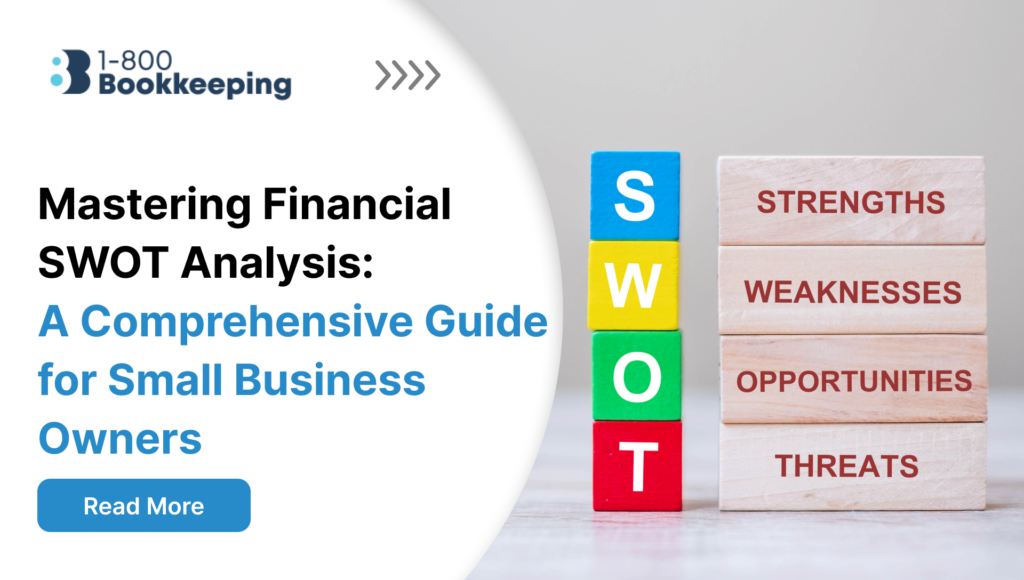Small business owners often face the challenge of efficiently managing their financial resources. One effective method to achieve this is through a comprehensive financial SWOT analysis. SWOT stands for Strengths, Weaknesses, Opportunities, and Threats, and it is a strategic tool used to identify and evaluate these four aspects in a business context. Conducting a financial SWOT analysis enables small business owners to make informed decisions, optimize resource allocation, and develop sustainable growth strategies.
Understanding the Components of a SWOT Analysis
A financial SWOT analysis consists of evaluating four key components:
- Strengths: Internal positive factors that provide a competitive advantage. Examples include strong cash flow, profitable product lines, and efficient financial management. Recognizing strengths helps businesses understand their core competencies and areas where they excel.
- Weaknesses: Internal negative factors hinder performance. These include high debt levels, poor cash management, and inadequate financial planning. Identifying weaknesses allows businesses to address vulnerabilities and improve overall efficiency.
- Opportunities: External positive factors that the business can leverage. These involve market expansion, technological advancements, or favorable economic conditions. Spotting opportunities helps businesses plan for growth and take advantage of emerging trends.
- Threats: External negative factors that pose risks. Common threats include economic downturns, regulatory changes, and increasing competition. Detecting threats allows businesses to develop strategies to mitigate potential risks.
By understanding these components, small business owners can better navigate their financial landscape and make more strategic decisions.
How 1800Bookkeeping Can Help with Financial SWOT Analysis
If you’re looking to optimize your business’s financial health, a well-executed SWOT analysis is a critical tool. At 1800Bookkeeping, we provide the expertise and resources you need to conduct a thorough and insightful financial SWOT analysis.
How We Can Help:
- Expert Guidance: Identify key financial aspects with our professional support.
- Comprehensive Reporting: Utilize our detailed financial reports.
- Actionable Insights: Implement tailored strategies.
- Ongoing Support: Monitor and adjust your plan for continued success.
- Technology Integration: Automate and streamline your analysis process.
Contact us today to take the next step in strengthening your business’s financial foundation!
Preparing for a Financial SWOT Analysis
Preparation is crucial for an effective financial SWOT analysis. Here are the steps to ensure a thorough assessment:
- Gathering Financial Data: Collect comprehensive financial records, including balance sheets, income statements, and cash flow statements. Having accurate and up-to-date financial data is essential for identifying strengths, weaknesses, opportunities, and threats.
- Setting Objectives: Clearly define the goals of the SWOT analysis. This might involve improving cash flow, reducing debt, or expanding into new markets. Setting specific objectives helps focus the analysis and align it with the business’s strategic goals.
- Involving Key Stakeholders: Engage individuals such as financial managers, accountants, and key team members with relevant insights. Involving stakeholders ensures that the analysis is comprehensive and considers multiple perspectives.
- Choosing the Right Tools: Utilize financial analysis software, spreadsheets, and other tools to facilitate data organization and analysis. Selecting the appropriate tools helps streamline the process and enhances the accuracy of the analysis.
Proper preparation ensures that the SWOT analysis is thorough and accurate, providing valuable insights for strategic planning.
Identifying Financial Strengths
Recognizing internal financial strengths allows businesses to leverage their advantages for growth. Here are some common strengths and methods to identify them:
Examples of Strengths:
- Strong Cash Flow: Sufficient liquidity to meet short-term obligations and invest in opportunities. A robust cash flow ensures the business can cover expenses and invest in growth initiatives.
- Profitable Product Lines are products or services that generate substantial revenue and profitability. Identifying profitable product lines helps prioritize resources and focus on high-return areas.
- Efficient Financial Management: Effective budgeting, cost control, and financial planning practices ensure optimal resource use and reduce waste.
Methods to Identify Strengths:
Analyze Financial Statements: Review income statements, balance sheets, and cash flow statements to spot positive trends. Financial statements provide a clear picture of the business’s financial health.
- Benchmarking: Compare financial performance with industry standards to identify areas where the business excels. Benchmarking helps highlight competitive advantages.
- Employee Feedback: Gather insights from staff directly involved in financial processes. Employees often have valuable insights into the business’s financial strengths.
Identifying financial strengths helps businesses build on their advantages and create a foundation for long-term success.
Recognizing Financial Weaknesses
Pinpointing areas of financial weakness is essential for addressing vulnerabilities and improving overall performance. Common weaknesses and techniques for identifying them include:
Common Weaknesses:
- High Debt Levels are substantial outstanding loans or credit that strain cash flow and can limit a business’s financial flexibility.
- Poor Cash Management: Inadequate handling of cash resources, leading to liquidity issues. Cash management can result in cash shortages and help operations.
- Inefficient Financial Planning results from a lack of strategic budgeting and forecasting, which can lead to financial mismanagement. Inadequate planning can also lead to missed opportunities and economic instability.
Techniques for Identifying Weaknesses:
- Financial Ratio Analysis: Calculate and analyze financial ratios, such as debt-to-equity and current ratios, to gauge financial health. Ratios provide insights into the business’s financial stability.
- Trend Analysis Examines historical financial data to identify negative patterns or inconsistencies. It helps spot areas that need improvement.
- External Audits: Engage third-party auditors to objectively assess financial practices and identify weaknesses. External audits offer an unbiased evaluation of financial health.
Addressing financial weaknesses helps mitigate risks and improve overall financial stability.
Spotting Financial Opportunities
Identifying potential financial opportunities can unlock new avenues for growth and profitability. Here are examples of opportunities and methods to spot them:
Examples of Opportunities:
- Market Expansion: Entering new geographic markets or customer segments. Market expansion can increase revenue and market share.
- Technological Advancements: Adopting new technologies to enhance operational efficiency and reduce costs. Technology can streamline processes and improve productivity.
- Economic Shifts: Capitalizing on favorable economic trends, such as lower interest rates or increased consumer spending. Economic shifts can create new growth opportunities.
Methods for Spotting Opportunities:
- Market Research: Conduct surveys, focus groups, and industry analysis to identify emerging trends and opportunities. Market research helps businesses stay ahead of trends.
- SWOT Workshops: Organize brainstorming sessions with key stakeholders to explore potential opportunities. Workshops foster creative thinking and collaboration.
- Competitor Analysis: Study competitors to uncover untapped opportunities or successful strategies that can be replicated. Competitor analysis helps identify gaps in the market.
Recognizing financial opportunities allows businesses to pursue growth and innovation proactively.
Detecting Financial Threats
Identifying external threats to financial stability is essential for developing mitigation strategies. Common threats and techniques for detecting them include:
Common Threats:
- Economic Downturns: Recessions or economic slowdowns that reduce consumer spending and revenue. Economic downturns can significantly impact sales and profitability.
- Regulatory Changes: New laws or regulations that increase compliance costs or restrict operations. Regulatory changes can create additional burdens for businesses.
- Increasing Competition: New or existing competitors that threaten market share and profitability. Competition can erode market position and reduce profitability.
Techniques for Detecting Threats:
- PEST Analysis: Evaluate political, economic, social, and technological factors that could impact the business. PEST analysis helps identify external factors that could pose threats.
- Industry Reports: Review industry publications and reports for emerging threats and trends. Industry reports provide valuable insights into potential risks.
- Scenario Planning: Develop and analyze potential scenarios to understand the impact of various threats. Scenario planning helps prepare for different outcomes.
Detecting financial threats enables businesses to safeguard their financial stability proactively.
Analyzing the SWOT Matrix
After identifying the strengths, weaknesses, opportunities, and threats, the next step is to analyze the collected data using a SWOT matrix. Here’s how to do it:
Creating a SWOT Matrix:
Organize the identified factors into a four-quadrant matrix for easy visualization.
- Strengths (top-left quadrant)
- Weaknesses (top-right quadrant)
- Opportunities (bottom-left quadrant)
- Threats (bottom-right quadrant)
Interpreting the Results:
Analyze the relationships between different factors. For instance, determine how strengths can be leveraged to capitalize on opportunities or counteract threats. Understanding these relationships helps prioritize actions.
Prioritizing Action Items:
Rank the identified factors based on their impact and feasibility. Focus on high-impact items that can drive significant improvements. Prioritizing action items ensures that resources are allocated effectively.
Creating and analyzing a SWOT matrix helps businesses understand their financial landscape and prioritize strategic actions.
Developing Strategies from the SWOT Analysis
The actionable insights gained from a financial SWOT analysis can be used to develop effective strategies:
Leveraging Strengths:
Use internal strengths to capitalize on opportunities and mitigate threats. For instance, a strong cash flow can be used to invest in technology upgrades that enhance efficiency.
Addressing Weaknesses:
Implement measures to overcome internal weaknesses. This might involve restructuring debt to reduce interest costs or improving cash management practices.
Capitalizing on Opportunities:
Develop strategies to take advantage of identified opportunities. This could include entering new markets, launching new products, or adopting new technologies.
Mitigating Threats:
Create contingency plans to deal with potential threats. For example, diversify revenue streams to reduce dependence on a single market or product.
The careful development of strategies based on SWOT findings enables businesses to navigate challenges and seize growth opportunities.
Implementing and Monitoring the Strategies
Once strategies are developed, the next step is to implement and monitor them to ensure their effectiveness:
Action Plan Creation:
Develop a detailed action plan that outlines specific steps, timelines, and resources required for each strategy.
Assigning Responsibilities:
Designate responsibilities to team members to ensure accountability and efficient execution.
Setting Milestones:
Establish clear milestones to track progress and evaluate the success of implemented strategies.
Regular Reviews and Adjustments:
Conduct regular reviews to monitor the effectiveness of strategies and make necessary adjustments. This ensures that the business remains agile and responsive to changing conditions.
Effective implementation and ongoing strategy monitoring help ensure the business achieves its financial objectives.
Conclusion
Conducting a financial SWOT analysis is a vital tool for small business owners to understand their financial landscape, make informed decisions, and develop sustainable growth strategies. By recognizing financial strengths and weaknesses, identifying business opportunities, and detecting business threats, businesses can create actionable strategies that drive success. Regular monitoring and adjustments ensure the business remains on track and adapts to changing conditions. Small business owners are encouraged to apply SWOT analysis as part of their financial management practices to achieve long-term growth and stability.
By following this comprehensive guide, small business owners can master the financial SWOT analysis process and leverage its insights to propel their businesses forward.
Don’t let Bookkeeping Overwhelm You. Hire 1-800 Bookkeeping
Running a business is demanding, and keeping track of your finances can be a never-ending chore. Many business owners need help with the complexities of bookkeeping, which can leave them frustrated and behind.
1-800 Bookkeeping offers expert services to streamline your financial processes and empower you to make informed decisions.
Our team of seasoned professionals understands the unique challenges businesses of all sizes face. We can help you:
- Free Up Valuable Time: Offload your bookkeeping tasks to our dedicated professionals.
- Gain Peace of Mind: Ensure your financial records are accurate and up-to-date.
- Make Smarter Decisions: Get actionable insights into your business performance through clear and concise reports.
- Feel Confident: Make informed financial decisions based on reliable data.
Don’t let bookkeeping hold you back from achieving your business goals. Contact 1-800 Bookkeeping today for affordable bookkeeping solutions.
FAQs:
1. What is a financial SWOT analysis, and why is it important for small businesses?
A financial SWOT analysis is a strategic tool that helps small businesses identify their Strengths, Weaknesses, Opportunities, and Threats. It’s essential because it enables business owners to make informed decisions, optimize resources, and develop strategies for sustainable growth.
2. How can small businesses identify their financial strengths?
Small businesses can identify their financial strengths by analyzing financial statements, benchmarking performance against industry standards, and gathering employee feedback. Recognizing strengths allows businesses to leverage their advantages for growth.
3. What are some common financial weaknesses, and how can they be addressed?
Common financial weaknesses include high debt levels, poor cash management, and inefficient financial planning. These can be addressed through financial ratio analysis, trend analysis, and external audits, helping to improve overall financial stability.
4. How do businesses spot financial opportunities?
Businesses can spot financial opportunities through market research, SWOT workshops, and competitor analysis. Identifying opportunities allows businesses to pursue growth and innovation proactively.
5. Why is it crucial to detect financial threats, and what methods can be used?
Detecting financial threats is crucial for safeguarding financial stability. PEST analysis, industry reports, and scenario planning can help businesses identify and mitigate potential risks.





